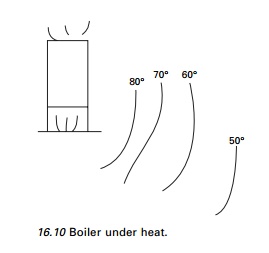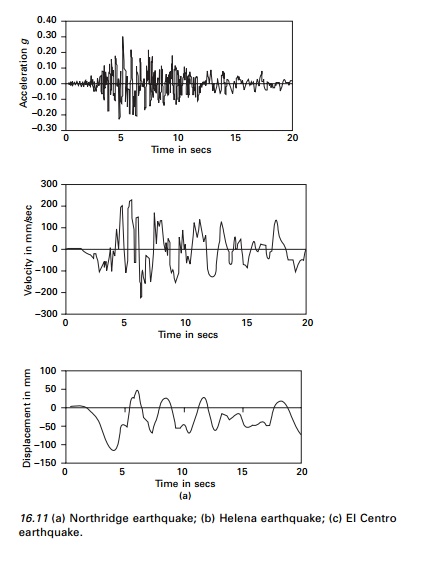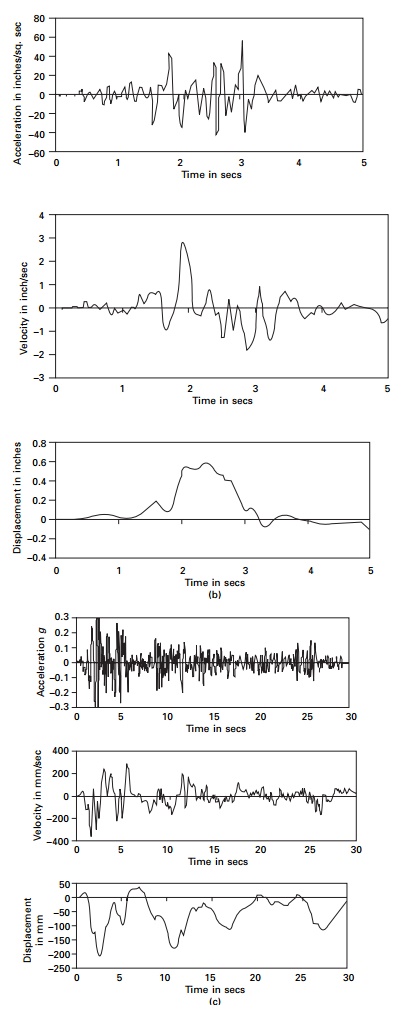Chapter: Civil : Structural dynamics of earthquake engineering
Earthquake ground motion
Earthquake ground motion
Strong earthquake ground motion must be recorded for
the purpose of seismic engineering. The ground motion is usually recorded with
strong motion accelerographs placed at various locations. The
acceleration record of a strong earthquake usually consists of two
horizontal components and one

vertical component. Generally, the two horizontal
components are of equal magnitude and the vertical component is somewhat
smaller. The accelerograph record frequently includes instrumentation errors,
owing to frequency characteristics of the accelerograph and other inherent
features that must be corrected by filtering and other procedures. The
corrected accelerogram is then integrated to obtain the velocity and
displacement histories of ground motion. The records of Northridge, Helena and
El Centro earthquakes are shown in Fig. 16.11. The Northridge accelerogram is
extremely irregular and complex and is a typical earthquake accelerogram
recorded on firm ground. On the other hand, on the surface of the soft strata
the earthquake ground


motion assumes an
almost harmonic nature, resulting from filtering of the seismic waves as they
travel through soft strata.
Earthquake
accelerograms are thus complex and can vary considerably from one another. They
are significantly affected by local site conditions, distance from the
causative fault, and the transmission path of the seismic waves. Newmark and
Rossenblueth classified earthquake ground motion into four groups in accordance
with their surface ground motion characteristics:
1. Single
shock type. This occurs only at close proximity with epicentre on firm strata
and for shallow earthquakes. Port Hueneme earthquake is an example for this.
2. A
moderately long, extremely irregular motion. This is associated with an
intermediate focal depth and occurs only on firm ground. It is typical of
earthquakes originating in the circum-Pacific belt. The NS component of 1940 E1
Centro earthquake is indicative of this type.
A long ground motion exhibiting pronounced
prevailing periods of vibration. Motions of the type are recorded at layers of
soft strata, through which seismic waves have been filtered and subjected to
multiple reflections at the layer boundaries. The 1964 Mexico City earthquake
exemplifies this behaviour.
4. A
ground motion involving large-scale permanent deformation of the ground. These
types of earthquake may entail landslides or soil liquefaction. The Alaska and
Niigata earthquakes of 1964 characterize this type of earthquake.
From the examinations
of the ground motions shown in Fig 16.11 three characteristics of ground
motions are important: (1) peak of maximum ground motion; (2) duration
of ground motion; and (3) the frequency content. The structural response
is affected by each of these factors. Peak ground motion, primarily peak ground
acceleration (PGA), influences the vibration amplitude, and has been employed
to scale earthquake design spectra and acceleration time forces. The severity
of ground shaking is significantly influenced by the duration of ground motion.
For example, an earthquake with high peak acceleration poses a high hazard
potential, but if it is sustained for only a short period of time it is
unlikely to inflict significant damage to many types of structures. Conversely
an earthquake with moderate peak acceleration and a long duration can build up
damaging motion in certain types of structure. Finally, ground motion
amplification to a structure is more likely to occur and the frequency content
of ground motion is in close proximity to the natural frequency of the
structure.
A correlation equation for peak ground acceleration
can be given in terms of Richter magnitude M as
Log10 PGA = –2.1 + 0.81M–0.027M2
----- 16.16
Table 16.9 shows peak
ground acceleration and time duration for various Richter magnitudes.
Equation 16.16 is site
dependent. Although PGA decreases with distance from the causative fault, the
rate of decrease is relatively small, over a distance comparable to the
vertical dimensions of the shipped fault. The values given in Table 16.9 are
conservatively high, and most actual earthquakes exhibit somewhat small values
of PGA.

Related Topics